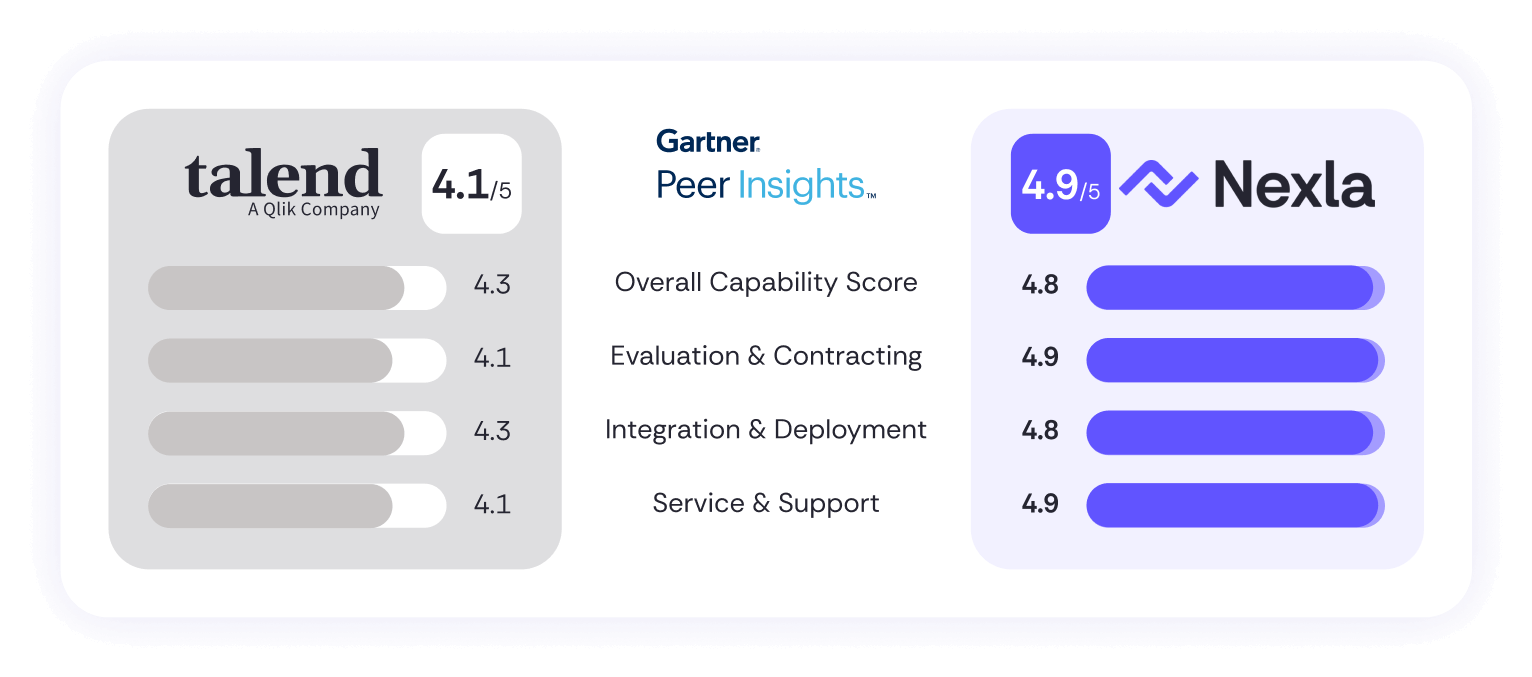
Nexla vs Talend
Compare the two vendors across 20 categories, including use cases, core capabilities, reliability, support, costs, ease of use, productivity, and customer ratings.
Speak with an Expert
Nexla vs Talend by the Numbers
Greater productivity for adding new connectors, data sources, data types
Faster time to new insights from weeks down to hours or less
Less maintenance, freeing up more time to innovate
Lower costs on staff, infrastructure, and vendors
Head-to-Head Comparison
Nexla continues to outperform Talend. See the differences between the two platforms.

Can invoke OpenAI LLM

Can invoke 20+ LLMs, use multiple encoding, extract context from leading vector databases or directly from any sources, move results anywhere, including chatbots

Yes

Yes

Limited API support

Yes

Limited EDI, API support

EDI, external data, B2B

ETL, ELT, CDC, API integration

ELT/ETL/R-ETL, CDC, streaming, API integration, API proxy, (S)FTP, bring your own (BYO)

Only 50+ fully manager connectors, 1000+ API connections

500+ connectors for SaaS, apps, data warehouses, lakes, Iceberg, streaming, Webhooks, APIs, databases, files, unstructured docs, and more

One-way ETL, ELT, API integration, streaming

Bidirectional read/write

Real-time and batch

Real-time, any batch interval

Data mapped to internal format

Any structured, semi, unstructured

No

Yes, on data fabric

No

Yes

Data quality and data governance capabilities. No schema evolution

Data validation and data quality, lineage approval workflows, schema evolution, RBAC

Multi-destination read/write

Multi-destination read/write

SaaS, private , self-hosted but more focus on Cloud today

SaaS, private, self-hosted

SDK

HIGH (new connectors, data)

HIGH

MEDIUM (30-50% decrease in deployment costs)

MEDIUM

HIGH (no-code, AI powered)

MEDIUM (limited flexibility)

HIGH (HIGH flexibility)

HIGH

HIGH

HIGH (several exclusions–read SLA policy for more)

HIGH
4 Reasons Why Leading Enterprises Choose Nexla over Talend
Talend combines proven ETL capabilities with support for some API and B2B integration. But Data Fabric is an older platform. Talend Cloud was released in 2015, 9 years after Talend Open Studio was released. It was expanded over time to become Talend Data Fabric before Talend was acquired by Qlik in 2023. Talend has evolved to support ELT, unstructured data, modern DataOps, or modular GenAI RAG.
Companies have chosen Nexla over Talend, and added Nexla to access and govern all their data, integrate faster, implement GenAI, and do it all up to 10x faster without coding, powered by AI.
- Support for any source or destination via APIs, and any data, in minutes
- Easily change destination formats
- Hundreds of pre-built connectors available out-of-the-box
- 3-8 hours for a new custom connector vs 1-3 months with others
- Use any integration style – ELT/ETL, R-ETL, streaming, (S)FTP, API integration and proxy, and more
- Support for real-time and batch
- Support multiple destinations
- Used for integration in AI, analytics, B2B, and operations projects
- Transparent pricing with 30-50% vendor cost savings vs Talend
- Eliminates additional personnel and the associated infrastructure costs – up to 10X ROI from adopting Nexla
- All-in-one integration platform – no need to buy multiple products
- Committed to customer success with a 96% recommend rate
- 5-star support – – higher than Talend
- Proven performance and scalability
- Trusted by top global brands like Carrier Global, DoorDash, Instacart, Johnson & Johnson, and LinkedIn

"Nexla has all the major integrations that you would ever want, and is very fast at creating custom integrations and connectors."
VP of Data, Analytics & Data Governance
